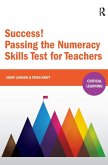Margie Pearse, Diane Devanney, Darla Nagy
Passing the Mathematics Test for Elementary Teachers
Offering a Pathway to Success
Margie Pearse, Diane Devanney, Darla Nagy
Passing the Mathematics Test for Elementary Teachers
Offering a Pathway to Success
- Broschiertes Buch
- Merkliste
- Auf die Merkliste
- Bewerten Bewerten
- Teilen
- Produkt teilen
- Produkterinnerung
- Produkterinnerung
Have you ever found yourself saying, "I'm never going to pass the math pre-service exam!" This statement, and many others like it, led the authors to discover exactly how to crack the math pre-service exam test code and students are reaping all the benefits. How to Pass the Pre-Service Mathematics Test for Teachers is the result of years of researching and experimenting with what it takes to not only pass the test, but come away from it a better test-taker and a stronger mathematician.
Andere Kunden interessierten sich auch für
![Passing the Mathematics Test for Elementary Teachers Passing the Mathematics Test for Elementary Teachers]() Margie PearsePassing the Mathematics Test for Elementary Teachers109,99 €
Margie PearsePassing the Mathematics Test for Elementary Teachers109,99 €![Success! Passing the Numeracy Skills Test for Teachers Success! Passing the Numeracy Skills Test for Teachers]() Trish KreftSuccess! Passing the Numeracy Skills Test for Teachers169,99 €
Trish KreftSuccess! Passing the Numeracy Skills Test for Teachers169,99 €![Success! Passing the Professional Skills Tests for Teachers Success! Passing the Professional Skills Tests for Teachers]() Jenny LawsonSuccess! Passing the Professional Skills Tests for Teachers170,99 €
Jenny LawsonSuccess! Passing the Professional Skills Tests for Teachers170,99 €![The Mathematics Education of Elementary Teachers The Mathematics Education of Elementary Teachers]() Lynn C. HartThe Mathematics Education of Elementary Teachers93,99 €
Lynn C. HartThe Mathematics Education of Elementary Teachers93,99 €![The Mathematics Education of Elementary Teachers The Mathematics Education of Elementary Teachers]() Lynn C. HartThe Mathematics Education of Elementary Teachers50,99 €
Lynn C. HartThe Mathematics Education of Elementary Teachers50,99 €![The Relationship between Calm Concentration Training Model and Reduced Test-Anxiety and Improved Academic Test Scores in Students The Relationship between Calm Concentration Training Model and Reduced Test-Anxiety and Improved Academic Test Scores in Students]() Cassandra HuffThe Relationship between Calm Concentration Training Model and Reduced Test-Anxiety and Improved Academic Test Scores in Students12,99 €
Cassandra HuffThe Relationship between Calm Concentration Training Model and Reduced Test-Anxiety and Improved Academic Test Scores in Students12,99 €![Ray's New Test Examples In Arithmetic (1883) Ray's New Test Examples In Arithmetic (1883)]() Joseph RayRay's New Test Examples In Arithmetic (1883)26,99 €
Joseph RayRay's New Test Examples In Arithmetic (1883)26,99 €-
-
-
Have you ever found yourself saying, "I'm never going to pass the math pre-service exam!" This statement, and many others like it, led the authors to discover exactly how to crack the math pre-service exam test code and students are reaping all the benefits. How to Pass the Pre-Service Mathematics Test for Teachers is the result of years of researching and experimenting with what it takes to not only pass the test, but come away from it a better test-taker and a stronger mathematician.
Produktdetails
- Produktdetails
- Verlag: Rowman & Littlefield Publishers
- Seitenzahl: 218
- Erscheinungstermin: 9. April 2015
- Englisch
- Abmessung: 254mm x 178mm x 12mm
- Gewicht: 420g
- ISBN-13: 9781475810844
- ISBN-10: 1475810849
- Artikelnr.: 41120978
- Herstellerkennzeichnung
- Libri GmbH
- Europaallee 1
- 36244 Bad Hersfeld
- gpsr@libri.de
- Verlag: Rowman & Littlefield Publishers
- Seitenzahl: 218
- Erscheinungstermin: 9. April 2015
- Englisch
- Abmessung: 254mm x 178mm x 12mm
- Gewicht: 420g
- ISBN-13: 9781475810844
- ISBN-10: 1475810849
- Artikelnr.: 41120978
- Herstellerkennzeichnung
- Libri GmbH
- Europaallee 1
- 36244 Bad Hersfeld
- gpsr@libri.de
Margie Pearse has over 25 years of teaching experience with certifications in mathematics, elementary education, ESL, and Pennsylvania Quality Assurance Systems (PQAS); Margie is presently the PECT Resource Coordinator and Instructor at Neumann University, state-wide PQAS educational consultant, and lead author of Teaching Numeracy: 9 Critical Habits to Ignite Mathematical Thinking, released in 2011 and Learning That Never Ends, released by Rowman & Littlefield in 2013. Her desire to help all pre-service teachers successfully attain their teaching certificates led her to research what it takes to pass the Math PAPA. Diane Devanneygraduated from Immaculata University, PA with a Bachelor of Arts in Mathematics, from West Chester University, PA with a Master of Arts in Mathematics, from Cabrini College, PA with a Master of Education and Widener Law School, Delaware with a Juris Doctorate. She has taught Mathematics for over 25 years, and is currently an adjunct instructor for Cabrini College and Penn State Great Valley. Darla Nagy graduated from Bowling Green State University, Ohio with a Bachelor of Science in Business Administration, graduated from Florida International University, Florida with a Master of Business Administration and graduated from Cabrini College, PA with a Master of Education and certification in secondary mathematics. She has worked as a programmer/analyst for Burroughs/Unisys Corporation, worked as a learning/math assistant in the Souderton Area and North Penn school districts, and is currently employed at Cabrini College as an adjunct math professor and a math tutor in the Math Resource Center. She is also employed as a tax preparer for H&R Block.
Acknowledgments
Chapter 1: Introduction - How to Pass the Math PAPA
Preparing for the Test - Proven Strategies for Successful Test Preparation
Taking the Test - Proven Strategies for Successful Test-taking
Chapter 2: Understanding Numbers and the Number System
Number Systems: The Hierarchy of Numbers
Decimals
Scientific Notation
Percents
Simple Interest and Compound Interest
Exponential Notation
Chapter 3: Pre-Algebra
Analyzing and extending a variety of patterns
Solving One Variable Equations and Inequalities Algebraically
Using the concepts of variable, equality and equation to generate,
interpret, and evaluate algebraic expressions
Manipulating algebraic expressions and solving equations using a variety of
techniques
Simplifying or combining like terms
Basic distributive property
Factoring an expression
Applying algebraic principles to represent and solve word problems
involving ratios and proportions
Chapter 4: Algebra
Graphing Lines and Inequalities
Graphing Parallel and Perpendicular Lines
Solving Systems of Linear Equations
Solving and Graphing Linear Inequalities and Systems of Linear Inequalities
Non-linear functions and real-world situations
Chapter 5: Measurement and Geometry
Measurement - The U.S. Customary System
Measurement - The Metric System
Perimeter, Area, Volume and Surface Area
Circles
Triangles
Quadrilaterals
Irregular Figures/Shaded Regions
Rectangular Prisms
Sphere
Angles and Lines
Coordinate Geometry
Transformations of Points and Geometric Figures
Chapter 6: Statistics and Probability
Measures of Central Tendency and Spread
Displaying Data and Statistical Information
Analyzing and Drawing Inferences from Data Presented in Different Formats
Probability - Simple, Compound, Independent, Dependent, Conditional
Counting Principles - Permutations and Combinations
APPENDIX
Full Practice Test 1 with Detailed Answers
Full Practice Test 2 with Detailed Answers
Full Practice Test 3 with Detailed Answers
Index
Chapter 1: Introduction - How to Pass the Math PAPA
Preparing for the Test - Proven Strategies for Successful Test Preparation
Taking the Test - Proven Strategies for Successful Test-taking
Chapter 2: Understanding Numbers and the Number System
Number Systems: The Hierarchy of Numbers
Decimals
Scientific Notation
Percents
Simple Interest and Compound Interest
Exponential Notation
Chapter 3: Pre-Algebra
Analyzing and extending a variety of patterns
Solving One Variable Equations and Inequalities Algebraically
Using the concepts of variable, equality and equation to generate,
interpret, and evaluate algebraic expressions
Manipulating algebraic expressions and solving equations using a variety of
techniques
Simplifying or combining like terms
Basic distributive property
Factoring an expression
Applying algebraic principles to represent and solve word problems
involving ratios and proportions
Chapter 4: Algebra
Graphing Lines and Inequalities
Graphing Parallel and Perpendicular Lines
Solving Systems of Linear Equations
Solving and Graphing Linear Inequalities and Systems of Linear Inequalities
Non-linear functions and real-world situations
Chapter 5: Measurement and Geometry
Measurement - The U.S. Customary System
Measurement - The Metric System
Perimeter, Area, Volume and Surface Area
Circles
Triangles
Quadrilaterals
Irregular Figures/Shaded Regions
Rectangular Prisms
Sphere
Angles and Lines
Coordinate Geometry
Transformations of Points and Geometric Figures
Chapter 6: Statistics and Probability
Measures of Central Tendency and Spread
Displaying Data and Statistical Information
Analyzing and Drawing Inferences from Data Presented in Different Formats
Probability - Simple, Compound, Independent, Dependent, Conditional
Counting Principles - Permutations and Combinations
APPENDIX
Full Practice Test 1 with Detailed Answers
Full Practice Test 2 with Detailed Answers
Full Practice Test 3 with Detailed Answers
Index
Acknowledgments
Chapter 1: Introduction - How to Pass the Math PAPA
Preparing for the Test - Proven Strategies for Successful Test Preparation
Taking the Test - Proven Strategies for Successful Test-taking
Chapter 2: Understanding Numbers and the Number System
Number Systems: The Hierarchy of Numbers
Decimals
Scientific Notation
Percents
Simple Interest and Compound Interest
Exponential Notation
Chapter 3: Pre-Algebra
Analyzing and extending a variety of patterns
Solving One Variable Equations and Inequalities Algebraically
Using the concepts of variable, equality and equation to generate,
interpret, and evaluate algebraic expressions
Manipulating algebraic expressions and solving equations using a variety of
techniques
Simplifying or combining like terms
Basic distributive property
Factoring an expression
Applying algebraic principles to represent and solve word problems
involving ratios and proportions
Chapter 4: Algebra
Graphing Lines and Inequalities
Graphing Parallel and Perpendicular Lines
Solving Systems of Linear Equations
Solving and Graphing Linear Inequalities and Systems of Linear Inequalities
Non-linear functions and real-world situations
Chapter 5: Measurement and Geometry
Measurement - The U.S. Customary System
Measurement - The Metric System
Perimeter, Area, Volume and Surface Area
Circles
Triangles
Quadrilaterals
Irregular Figures/Shaded Regions
Rectangular Prisms
Sphere
Angles and Lines
Coordinate Geometry
Transformations of Points and Geometric Figures
Chapter 6: Statistics and Probability
Measures of Central Tendency and Spread
Displaying Data and Statistical Information
Analyzing and Drawing Inferences from Data Presented in Different Formats
Probability - Simple, Compound, Independent, Dependent, Conditional
Counting Principles - Permutations and Combinations
APPENDIX
Full Practice Test 1 with Detailed Answers
Full Practice Test 2 with Detailed Answers
Full Practice Test 3 with Detailed Answers
Index
Chapter 1: Introduction - How to Pass the Math PAPA
Preparing for the Test - Proven Strategies for Successful Test Preparation
Taking the Test - Proven Strategies for Successful Test-taking
Chapter 2: Understanding Numbers and the Number System
Number Systems: The Hierarchy of Numbers
Decimals
Scientific Notation
Percents
Simple Interest and Compound Interest
Exponential Notation
Chapter 3: Pre-Algebra
Analyzing and extending a variety of patterns
Solving One Variable Equations and Inequalities Algebraically
Using the concepts of variable, equality and equation to generate,
interpret, and evaluate algebraic expressions
Manipulating algebraic expressions and solving equations using a variety of
techniques
Simplifying or combining like terms
Basic distributive property
Factoring an expression
Applying algebraic principles to represent and solve word problems
involving ratios and proportions
Chapter 4: Algebra
Graphing Lines and Inequalities
Graphing Parallel and Perpendicular Lines
Solving Systems of Linear Equations
Solving and Graphing Linear Inequalities and Systems of Linear Inequalities
Non-linear functions and real-world situations
Chapter 5: Measurement and Geometry
Measurement - The U.S. Customary System
Measurement - The Metric System
Perimeter, Area, Volume and Surface Area
Circles
Triangles
Quadrilaterals
Irregular Figures/Shaded Regions
Rectangular Prisms
Sphere
Angles and Lines
Coordinate Geometry
Transformations of Points and Geometric Figures
Chapter 6: Statistics and Probability
Measures of Central Tendency and Spread
Displaying Data and Statistical Information
Analyzing and Drawing Inferences from Data Presented in Different Formats
Probability - Simple, Compound, Independent, Dependent, Conditional
Counting Principles - Permutations and Combinations
APPENDIX
Full Practice Test 1 with Detailed Answers
Full Practice Test 2 with Detailed Answers
Full Practice Test 3 with Detailed Answers
Index









